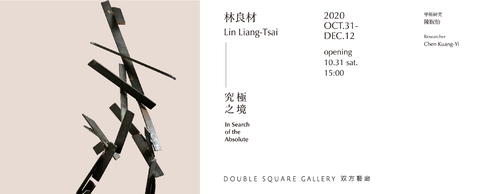In Search of the Absolute
10/31 (Sat) - 12/12/2020 (Sat)
Lin Liang Tsai

Exhibition dates:2020.10.31-2020.12.12
Exhibition venue:Double Square Gallery
Researcher:Chen Kuang-Yi
Double Square Gallery is delighted to present Lin Liang-Tsai’s solo exhibition, In Search of the Absolute, which opens on October 31, 2020. Lin was born in Changhua in 1947. He is deaf and mute since birth, but possesses incredible artistic talents. An internationally esteemed and acclaimed artist, he is the recipient of the Award of Royal Academy of Arts (1989) and the Wu San-Lien Arts Award (2008), and has been commissioned to create the European June 4th Democratic Monument, entitled The Torch of Freedom. Throughout his creative career spanning more than five decades, Lin’s work, both painting and sculpture, has always featured the subject of “human.” Using paint brush or metal plate, he delineates the joy and sorrow of this world. In Search of the Absolute marks the artist’s first collaboration with Double Square Gallery and invites Chen Kuang-Yi, the Dean of the College of Fine Arts, National Taiwan University of Arts, to be the academic chair. The exhibition features a fine selection of twenty-five artworks from Lin’s creative journey over the past thirty years, including sixteen new works that have never been shown before. The exhibition runs until December 12, 2020.
In his soundless world, Lin has observed the world through his hands, eyesight and mind, and sincerely express his inner feelings and thoughts on life with his unique artistic talents. Before turning forty, he mainly created oil paintings; and after forty, he has shifted to three-dimensional sculpture. At an earlier age, Lin was mentored by art master, such as Yang San-Lang, Liao Chi-Chun and Li Mei-Shu, and was particularly influenced by Liao Chi-Chun, who was nicknamed a Fauvist master of colors. He therefore created paintings of vibrant colors and simple lines that visualized his personality, sensitivity and endurance on canvas. In 1984, Lin started studying in Belgium at the age of thirty-seven, after which he shifted his focus to three-dimensional sculpture, choosing versatile cast iron and bronze as his mediums. Replacing canvas and paint brush with metal plate and hammer, Lin transforms solid metal into figural sculptures exuding a vivid sense of life through constant hammering, forging and cutting. He especially likes to watch the process of erosion on metal. As a layered texture is revealed after rusty flakes fall off the smooth metal surface and the rust slowly turns into a reddish hue, the sculpture becomes warmer and softer for the artist. Lin incorporates the linear aesthetics in Eastern calligraphy into his work, cleverly infusing the interplay of the real and the void as well as yin and yang observed from nature to demonstrate life’s resilience and tenderness.
The exhibition title is inspired by French philosopher Jean-Paul Sartre’s essay, “In Search of the Absolute.” The changes brilliantly engendered by intermixing three-dimensional form, two-dimensional division, linear extension as well as dents and openings in Lin’s works echo Sartre’s description of the nature of emptiness. Lin’s sculpture starts with nothingness and explores the image of humanity that oscillates between “existence and emptiness” with innovative expression. His sculptural language has gradually evolved from portraying the full human form and reinforcing the subject matter and structure to delineating the curves of muscles and power, mirroring the struggles of the human psyche with pure depiction of the body. In Search of the Absolute will feature March in Storm 3 and March in Storm 4 from Lin’s brand new series, March in Storm. The artist changes his usual approach of hammering and forging, and turns to express a more refined and freer structure of the human body with linear expression and a sense of volume, utilizing solid but rhythmic iron lines to delineate the utmost dimension of simplicity. Lin’s creative spirit and artistic life have enabled him to transcend the barriers of physical challenges and fate, allowing him to consistently challenge himself. With bronze and iron plates, he has labored in the most straightforward and truthful way to convey his thinking about the “body,” unfolding the multifaceted world while achieving the depth and width of his own life through his sculpture.